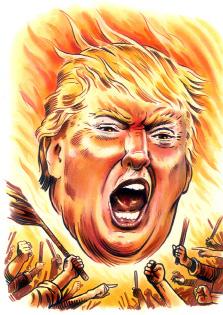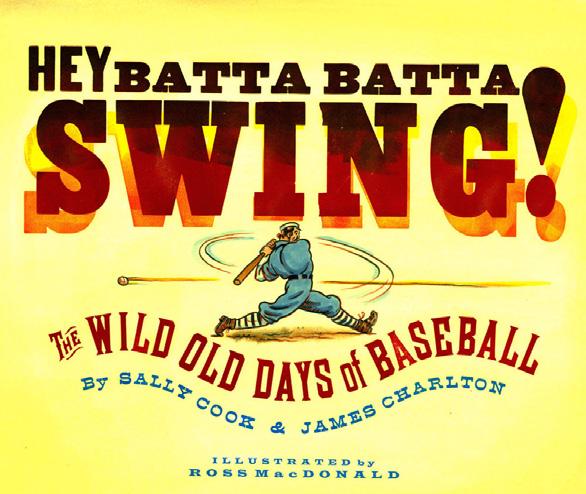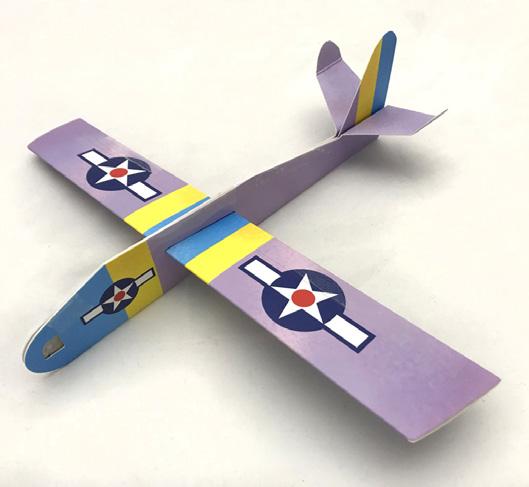
13 minute read
Ross MacDonald
Ross MacDonald
PERFECTLY VERSATILE WITH STYLE
Advertisement

For many years Ross MacDonald has been a contributor to periodicals like Vanity Fair, The New York Times, The New Yorker, Newsweek, Time, and Rolling Stone, creating illustrations and writing humor pieces.


He also authored and illustrated 4 children’s books, as well as the adult humor books In and Out with Dick and Jane, (with co-author James Victore) and What Would Jesus Craft? Yet all the while he has led a secret double life designing and fabricating props for over 40 movies and television series. He has made everything from the book Bradley Cooper’s character throws out the window in Silver Linings Play-book, to the titular Book of Secrets for the second National Treasure movie; Jennifer Lawrence’s mop patents for Joy; baby’s favorite book in Baby’s Day Out; Nucky Thompson’s checkbook and Arnold Rothstein’s calling card for
Boardwalk Empire; the morgue toetags in The Knick; the Pawnee town charter for Parks and Recreation; the Red Tobacco tin in Tarantino’s Hateful Eight; Versace’s book in the latest season of American Crime Story and thousands of other props.
Born and raised in the backwoods of Canada, he lived for many years in New York City before finally washing up on the bucolic shores of Connecticut.
I had the pleasure of doing a Pod cast with Ross and I found him to be thoughtful, funny and full of life. He's an example of making the right choices in his life and thriving. I was particularly impressed by his candor and willingness to share his story and methods of working. His story is a great example of being prepared when opportunity presents itself.
And now our interview...
When did you first think about art as something you wanted to do? Were you encouraged or discouraged by family, friends, teachers, mentors?



I liked to draw when I was a kid, although most of my family wasn’t at all artistic. When I was in second grade, I was confined to a hospital bed for 6 months. I read and reread tons of Classics Illustrated comics and drew for entertainment. A little later my older brother got kicked out of high school and sent to a vocational school, where he took art classes. When he’d come home, he’d bring his assignments and hang them on the wall of the bedroom we shared. That was the first time I realized that drawing was something a grown-up person could do. Going to school in tiny towns in rural Canada, there were no art classes, but that tiny glimpse of the world of art and design and illustration was hugely impactful.




timely I guess. When I took those around, I got magazine work. Later, because of deadline pressures, I stopped doing 7-color lino-cuts, and started coloring black lino-cuts with watercolor. Then I started doing all-watercolor illustrations. But I still do flat-color illustrations, and I also still do lino-cuts sometimes.

What kind of kid were you? What were your influences?
I was a scrawny bespectacled kid but I was pretty active. I grew up in rural Canada. I was the youngest kid in a large family. I used to run around with my friends and play in the woods and fields. We moved a lot when I was a kid so I lived in different towns in southwestern Ontario, Alberta and Saskatchewan. There weren’t a lot of books in our house when, but there were 2 sets of old encyclopedias, and a twelve-volume set of kids books called My Book House. It was published in Chicago in 1930 and was actually a great set of books, illustrated by some of the top kids book illustrators of the day. Those illustrations have been a huge influence on me, since I spent so much time with them. I used to research obscure subjects in the encyclopedias – something that I still do for my prop and product design work, although I don’t use encyclopedias anymore. I used to like to design and make stuff when I was a kid too – home made rockets and fireworks, bows and arrows, leather stuff, metalwork, wood carving. I made a telephone microphone from an old battery and an oil-can, built an electronic proximity switch, an AM receiver, and a gas mask, which I wore on long car rides with my chain-smoking parents. I guess I was a weird kid.
Your style is very unique. Did that naturally come out of you?
Yeah, it just sort of developed, depending on what I was doing or interested in. I dropped out of high school and left home when I was in my teens, and moved to Toronto. I worked as a printer at a printing/publishing place called Coach House Press, where I rubbed elbows with a lot of poets and writers and artists. Then, with my older brother, I helped start a letterpress printing/publishing house called Dreadnaught Press. When I first started doing illustrations, they were small lino-cut decorations. Then I started doing larger pieces. They were a weird mix of lino-cut, influenced by my 1930s kids books. It was early 1980s, and that combo somehow seemed to work.
How did those Trump pieces come into being?

It’s almost impossible to avoid Trump, and he manages to hit new lows daily – hourly! So there’s lots of material to work with for sure. I think there’s a lot of visual anti-Trump stuff that verges on being heavy-handed, and frankly hysterical. To show him as the destroyer of civilization is not only hyperbole, it gives him WAY more credit than he deserves. Remember those Tea Party posters of Obama as Hitler and the Joker? Me neither. Humor and satire is harder to ignore, more interesting, lasts longer, has more room for new material, and shows these buffoons as they truly are, to my mind anyway. And people HATE being laughed at.
It’s funny – back in the summer of 2015 I put together a huge proposal for a book called How To Speak Trump. It was a humor book, full of his words and phrases, with satirical definitions. There were also various sidebars, illustrations, etc. Publishers liked it, but none of them wanted to touch it. The general consensus was that Trump would be long gone by the time the book came out. I should have asked if any of those editors were willing to put money on that. Another missed opportunity.



In a time when digital type was in its infancy. Most of the foundries and printers were starting to see the writing on the wall, and we were able to pick up huge amounts of type and equipment. A few years later we started a branch operation in Bear River, Nova Scotia. We had 2 buildings, with a large handmade paper mill, a type casting operation with 3 mono-type casters and 2 keyboards, a print shop with a large Vandercook and a K-model Heidelberg flatbed letterpress that I had restored. We did a fair amount of publishing, but also a lot of job work. Some of that tended to be high-end, custom designed and fabricated pieces for promotion, special events, etc. We also got into book packaging – that’s where I started writing and illustrating children’s books.

How did different types of projects come to you?
Magazine illustration was something I really went after, but the rest is pretty much dumb luck. Someone would see an illustration and call me, or I’d run into somebody somewhere. My current children's book agent called me because she knew my magazine work. In 1993 I got talking to another guy at a party – he was about to start working on the movie Baby’s Day Out, and they’d been trying to find an illustrator for a faux 1930’s children’s book. He remembered my work from magazines. Long story short, I worked on location in Chicago for 6 months and made a lot of friends who worked in the movie industry, and learned a lot from them. The movie work just snowballed from there.
How has the computer affected your work?


I work mostly traditionally, but I scan in artwork and tweak it. I also color some work digitally. For my prop work, I couldn’t really do it, or do it as well, without the Internet. Research is a huge part of that work. I do some of the prop work traditionally – hand drawn artwork, hand drawn type, letterpress printed from handset wood and metal type. I also bind books, do leather work, etc. But a lot of the prop work is designed and set digitally, printed on ink-jet printers, but then hand bound and/or hand aged, etc. The Pawnee town charter for Parks & Recreation is an example of that.
So I did that stuff for years. In the early 80s I started striking out on my own a bit. It meant I had to do years of house painting and construction and landscaping to support myself, but I started doing freelance illustration, worked in a children’s performance group, worked for an animation studio, and worked building sets and props in local television. Around the mid 80’s the illustration started to take off. I moved to New York in 1987, where I met and married my wife. About ten years later, I was starting to self publish promotional pieces, like the Get Tough poster I did with James Victore. We were hiring local printers, and I started to think maybe I should buy a small press and a few fonts of type for printing my own stuff. It wasn’t long before a few small things turned into a large collection of type and equipment. I was mainly using it for promotional pieces and for special projects with designers I knew. But I was inadvertently building a huge resource for prop work.

Your comics seem to be political. Where does that come from?
My parents were both in the military and were fairly conservative, and rural Canada wasn’t exactly a hotbed of liberal politics. But after I left home, I lived and worked with hippies and artists. I guess if my political lean comes from anywhere, that’d probably be it. Lately my comics have been confined to social media posts. I haven’t had many comics published in the last few years, but the New York Times was kind enough to run many of them back in the day. I did maybe a dozen comics for the Op Ed page, and I also did comics for other sections of the Times – the Book Review, Real Estate, etc. I also did comics for Time, Newsweek, Entertainment Weekly and PC Magazine. I also did a regular comic for the Virginia Quarterly Review.
What’s does your process entail? Can you give us a short step-by-step?
I doodle lots of tiny thumbnails – usually about an inch or so big – on a 9x12 bond paper pad with a non-repro blue lead in an automatic pencil. Once I get one that might work, I’ll draw over the blue with a super fine pen. I scan that with my iPhone using Turbo Scan. I eyeball the size so it’s maybe 3 inches big on the page, then I print it out using air-print. I put that print under a sheet of the bond and trace over it in non-repro blue, then draw over that in pen. Often that’s tight enough to blow up and trace the final art from. Sometimes I have to trace over it again and redraw, or scan it in and make adjustments or corrections in Photoshop.
For most of my illustrations, I trace the final art onto 90 pound hot press watercolor paper or Strathmore 500 series bristol, vellum surface. I trace the lines with a Terracotta Prismacolor. Then I paint it with watercolor dyes. I’ve always used Peerless dyes – they seem to be a lot more light-fast than the others, and I like the old school colors. I tend to use a small range of colors – sepia, burnt umber, burnt sienna, India yellow, Prussian blue, indigo, vermillion, orange and a couple of greens. The dyes come in liquid form, but I put them into ceramic slants and let them dry out, then I mix a little water in when I use them. I usually tape the paper down onto a board, wet it, and then lay down a pale yellow wash. I do a lot of the first washes wet-in-wet, but then dry it with a heat gun, and lay down more color. Once all of the watercolor is dry, I go over the Terracotta lines with an indigo blue Prismacolor. I got the idea for that years ago by observing how old lithograph posters often achieved a black by laying blue over red. I like how I can get a lot of variation in the line by overlapping or not overlapping the 2 colors. Sometimes I do the line in India ink with a brush and pen, and then watercolor that. For the little pieces, I do the line with a Rotring Tikky Graphic pen. They’re really black and totally waterproof.

What’s the future hold for Ross? Ultimate goal?
I’ve never really had any long-term goals, or if I ever did, I quickly forgot them. I know we’re all supposed to have long-term goals, but I’m too “anything shiny on the ground”. I just love making stuff, researching stuff, designing stuff, drawing stuff, trying new things, and I’ve been lucky enough to have clients who hire me to do just that. When I hear people talk about retiring, I feel a bit sad for them. I wonder if that means that they are not doing what they like, and can’t wait to stop doing it once they’ve made enough money. I’ve never been lucky enough to make enough money to set any aside for retirement, especially since I blow it all on dumb shit like old books, ephemera, type, and presses. But I am lucky enough to love what I do and so far I don’t ever see a time when I’ll want to stop doing it and plant my ass in a rocking chair. The work can be hard – very hard – and I often work long hours, 7 days a week for months at a stretch. But it’s always interesting and I learn new stuff all the time. And sometimes I can pay a bill.


